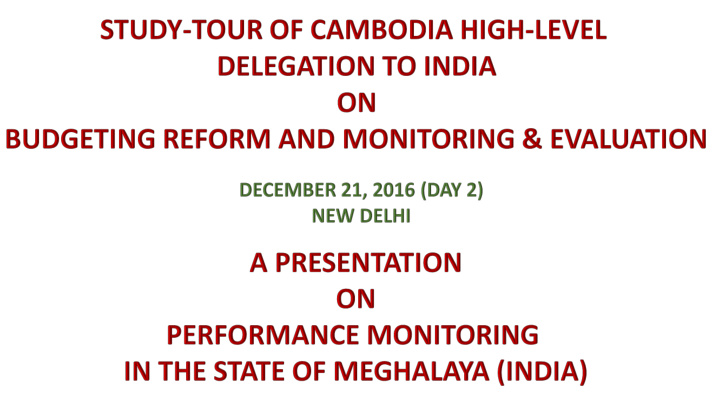



Hon’ble Chief Minister: Dr. Mukul Sangma Hon’ble Governor: Shri V. Shanmuganathan Carved from the erstwhile State of Assam, Meghalaya became a full fledged State on January 21,1972. The word ‘Meghalaya’ comes from Sanskrit word ‘the abode of clouds’ . Bounded on the North and East by Assam and on the South and West by Bangladesh, Meghalaya is spread over an area of 22, 429 square kilometres, and lies between 20.1° N and 26.5° N latitude and 85.49 °E and 92.52 °E longitude. Area: 22,429 Sq.Kms. Population: 29,64,007 (2011 Census) Capital: Shillong Language: Khasi, Pnar and Garo Community Development Blocks: 39 Districts: 11 Mon-Khmer form of language in Cambodia
Major Mineral Resources Coal, Limestone, Silimanite, Dolomite, Fireclay, Felspar, Quartz and Glass-sand. Principal Forest Produce Timber, Bamboo, Reed, Cane, Ipecac, Medicinal herbs and Plants, Cinnamon, Lemon-grass and Thatch-grass. Principal Agricultural Products Rice, Maize, Potato, Cotton, Orange, Ginger, Tezpata, Arecanut, Jute, Mesta, Banana and Pineapple. Wildlife Animals: Elephant, Tiger, Leopard, Bear, Panther, Wild Boar, etc. Birds: Duck, Hornbill, Myna, etc.
Tourism - Root Bridge Agriculture - Paddy Tourism - Mawsmai Cave
List of State Government Department (52 Departments): Agriculture General Administration Planning Animal Husbandry and Veterinary Governor's Secretariat Political Arts & Culture Health & Family Welfare Power Border Areas Development Home (Civil Defence and Home Guards) Printing & Stationery Cabinet Affairs Home (Jails) Programme Implementation & Chief Minister's Secretariat Home (Passport) Evaluation Commerce & Industries Home (Police) Public Health Engineering Communication Housing Public Works Community & Rural Development Information & Public Relations Revenue & Disaster Management Cooperation Department Information Technology Secretariat Administration District Council Affairs Labour Sericulture & Weaving Education Law Social Welfare Elections Legal Metrology Soil & Water Conservation Excise Registration Taxation Stamps Legislative Assembly Secretariat Sports & Youth Affairs Finance Mining & Geology Tourism Fisheries Parliamentary Affairs Transport Food Civil Supplies & Consumer Affairs Personnel & Administrative Reforms Urban Affairs Forests & Environment Water Resources
Introduction to Performance Monitoring by Dr. Prajapati Trivedi, Secretary to Govt. of India (Performance Management Division (PMD)) Cabinet Secretariat, Govt. of India to Dr. Mukul Sangma, Hon’ble Chief Minister, Meghalaya in 2013. Resolution by Secretaries Committee under the chairmanship of the Chief Secretary, Meghalaya to adopt performance monitoring / management using Performance Management Division’s methodology called Results Framework Document (RFD). To kick start adoption of RFD methodology, an RFD Workshop in association with PMD was held during 2013 by way of preparing 6 RFDs of six State Government Departments. Programme Implementation & Evaluation Department was identified as the Nodal Department for implementation of RFD by the State Government Departments in the State. Secretary of the Department was the RFD State Nodal Officer. Each Department also identified a Departmental RFD Nodal Officer. Technical interaction sessions were conducted by the Nodal Department with the RFD Nodal Officers from time to time to build their capacity to prepare good RFDs. To facilitate adoption of RFD methodology by the State Government Departments, an in-depth RFD Workshop in association with PMD was held and 41 RFDs of 41 State Government Departments were prepared during 2015-16.
• Most of the Departments have problems in drafting the Vision Statement, the Mission Statement and the Objectives of RFD. • Departments are implementing Programmes and Projects whose Vision Statement and Mission Statement belong to higher level Programmes i.e. at the Government of India level. • There are projects whose implementation go beyond one year and to make Performance Annual Targets become cumbersome to certain Departments. • There is a need to get the involvement of the Political Level and the Senior Management Level while framing the RFDs from year to year without which the initiative would be futile. • There could be tendencies that Departments would simply prepare and submit the RFDs but will not be serious to use it to measure their annual performance. • There is a need to build up the basic ICT working skills of at least using the Internet by the RFD Nodal Officers so as to facilitate online submission of RFDs into the online Results Framework Management System. • There is a need to prepare realistic RFDs and the Results Framework Evaluation Methodology of the PMD is a valuable resource to make better RFDs and this had helped the RFD Nodal Officers to prepare relatively good RFDs during 2015-16. • Efforts are being made to take from having an RFD to using an RFD which is our goal in performance monitoring.
SHARE OF RFD EXPERIENCE IN GOVERNMENT OF MEGHALAYA • RFD Evaluation Methodology helps to quantify the tangible and intangible annual targets. • RFD Preparation and Online Submission are user-friendly and therefore easy to learn and practice. • Departments implementing RFD Evaluation Methodology are more focused to results, outcomes & benefits. • RFD Annual Targets are well within the Plan Horizon and therefore more realistic. • Departments are oriented towards their Vision and Mission and therefore more productive and transformative.
Recommend
More recommend